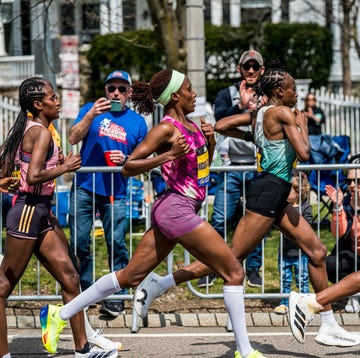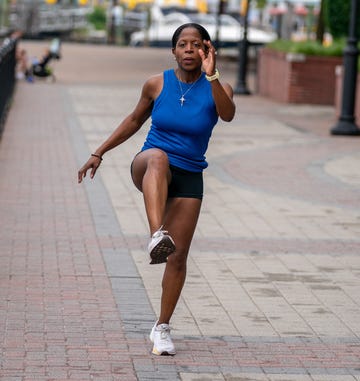Ever blown up in a race because you couldn't work out how to pace it right in the conditions or on tricky terrain? Read on. Running power - a new way to see how hard you are working when you run - is about to go mainstream, and it might just be the answer to your pacing woes.
It's a bold claim, but bear with us and hear out the details. From what running power actually is and the main benefits of using it, to some of the best gear for tracking this new stat, here’s your essential guide to everything you need to harness the power.
What is running power?
Simply put, running power - expressed in Watts - is a way to measure the output of the work you’re doing when you run. The higher the Watts, the more power you’re generating with every step.
What everyone's reading
This may all be immediately familiar to cyclists, who have been using power for a long time as a reliable and consistent performance metric in both training and racing. So why hasn't power been used in running before? Because unlike in cycling, where you are working in a fixed position on the bike, there are far more variables - both biomechanical and also situational - that can make it much harder to generate accurate data. And without accuracy, it's not really much use as a training data point.
However, with smaller and increasingly powerful sensor technology - particularly accelerometers – new products are emerging that that bring power data to runners too.
Of course, as with any biomechanical measurement there’s still a healthy scientific debate about how best to measure running power, what’s actually being measured and how to apply it to training. We’re not going to dive into all that detail here, but let’s just say this emerging technology has some excellent benefits, particularly when used in conjunction with existing information such as pace, heart rate and how we feel.
After all, the more power you can generate at a lower heart rate or faster pace, the more efficient you are - and efficiency is the secret weapon of fast runners. Power can be used with a certain degree of accuracy to the reflect the metabolic cost of your efforts and also offers a new way to measure the load on your muscles.
The big benefits of running with power
One way to understand the potential benefits of running power is by looking at some of the problems with the existing running metrics that many of us use, namely pace, heart rate and 'feel' or RPE - Rate of Perceived Exertion.
Despite the fact that as runners we all obsess about pace, it’s actually quite a blunt instrument for training and racing. After all, it doesn’t reveal how hard your body is working, only the results of the work - and it doesn't work well on hills either.
For example, if your running plan has you down to do a tempo run at a specific pace, and you live in a very hilly part of the world, the chances are you’re either not going to maintain that pace consistently, or you’re going to be working a lot harder than someone who runs the same session but lives somewhere much flatter.
But on race day, unless you’re running a pancake flat course, actually adjusting your pace to reflect the elevation and the effort involved is incredibly complicated. And let’s face it - none of us is great at doing difficult sums at mile 22 of a marathon.
So then there’s also heart rate – a measure of the work your cardiovascular system is doing. But this too struggles with hills or rapid increases in running intensity. For example, for track sessions where you’re doing 400m repeats you’ll often see a lag as your heart rate plays catch up with what’s actually happening.
Related: Running, heart rate and what is a 'normal' resting rate
Similarly if you’re doing hill repeats, it’s quite common to see your heartrate BPM readings fall behind. It doesn’t respond in real time, and that means you can be working well above your desired rate long before your watch alerts you to it.
Your heartrate is also affected by other external factors such as how well you slept, whether you’re stressed, ill or even if you’ve just had a large coffee. As a result, useful as it is in some cases, heart rate isn’t an entirely reliable measurement of your work rate either.
Finally there’s RPE, or running on feel. The biggest drawback with this is that we’re all brilliant at lying to ourselves in the first few miles of a race where the adrenaline is pumping and we feel invincible. At this point it’s all too easy to misjudge what’s a comfortable, maintainable intensity for the whole race. Often you only realise you’ve got this wrong when the Struggle Bus comes for you deep into the race.
So how does power help?
Power brings something new to the table, plugging those gaps in our data. For a start, it responds instantly in real-time with every step.
And because power tracks the actual output, rather than your heart’s response to the work needed to produce the output, or the result of that output in speed or pace, it’s possible to get a consistent reading that reflects your work rate whether you’re running on the flat or uphill.
If you run a stretch of flat at 230 Watts and your pace equivalent is 8 minute miles, when that flat turns into a decent hill, in order to maintain a steady 230 Watts, the chances are you’re going to have to slow down. But the work you’re doing to maintain the even wattage will be the same.
There are some caveats to this. Wind and heat are two external factors that a power metre can’t read, and another is softer ground underfoot. Running downhill presents some problems too, but on the whole the stats you get are a reliable guide to what’s actually going on.
Perfect pacing?
One of the most promising practical applications for power is helping to pace races evenly.
The best power-tracking devices offer calculators that let you quickly assess what power you’ll be able to maintain for any distance, certainly up to a marathon.
The Stryd partner app, for example, takes a recent 5k, 10k, half or marathon time, lets you select your target race distance (from the same distances listed here) and then provides you with a target in Watts. This power target – one single number – represents the output you can sustain without busting your threshold and heading for the wall.
What that means in practice, is that by sticking to this one number, you can control your race from start to finish without the risk of blowing up. You might even find you have a little more to give in the final miles but you’ll at least be in a position to make that call.
There is an important twist here though. You don’t get to decide your target time. Instead you have to trust that the power target you calculated will give you the race outcome your training deserves. You’re no longer shooting for a time you’ve decided you think is possible and that’s quite a hard concept to grasp.
It shifts the emphasis from what you think you might be able to do to what your current objective fitness will allow you to do.
If you’ve trained well and your race power target calculations are done correctly, you’ll be in with as much of a chance of a PB with a run that’s not wrecked by poor pacing strategy.
Spot improvements in performance
Used in conjunction with heart rate, power is a great tool for identifying improvements in performance. For example, if you repeat the same session two weeks apart and you find you’re running at same power but with a lower heart rate, that’s a sure sign of better efficiency, aka an improvement in your running form. The sames goes for producing equivalent pace to power.
Manage your training load
When you run you’re placing stress on two systems, the cardiovascular system and the muscular system. While heart rate can track cardio load, before power metres we didn’t really have a way to measure the strain on the muscles.
By monitoring power during training runs devices like the Polar Vantage V and Stryd deliver a more holistic assessment of the true training load. That can then be used to prescribe training and rest more effectively.
Zone training
Just as you can with heart rate, it’s possible to generate power-based target zones for the different running states including recovery, steady, threshold and tempo, VO2 Max and speed work interval sessions and repetitions.
And because there’s no time lag with power, you can hit these zone more quickly and more accurately than you would using heart rate. For example you can ensure you’re training in the 80-85 percent threshold zone from the very first 100 metres.
Which products track running power?
A pod that clips onto your shoelaces, the Stryd sensor uses motion-sensing accelerometers to measure power from the foot. It works with an app, or hooks up to most running watches, to let you see your power in real time.
A set of 100g smart soles with accelerometers and 30 pressure sensors, these inserts slip into your running shoes to capture power readings from each step. These are sent in real-time to a partner smartphone app.
The first running watch to track running power from the wrist, the new Vantage V estimates power using GPS-based speed and data on elevation captured by its built in barometric sensors. This cuts out the need for additional sensors but the downside to this is that it doesn’t work for indoor runs.
Related: 5 ways the Polar Vantage V could change the way you train
Garmin Running Dynamics Pods or HRM-Run/Tri
Three running accessories from Garmin track power. The dynamics pod is a belt-clipped pod and the HRM-Run and Tri are standard chest straps. Both work with select Garmin watches such as the Fenix 5 and Forerunner 935 via a downloadable a Garmin Connect app.














